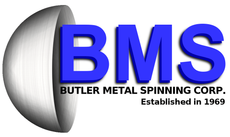For All Your Metal Spinning Needs
,
This is a placeholder for the Yext Knolwedge Tags. This message will not appear on the live site, but only within the editor. The Yext Knowledge Tags are successfully installed and will be added to the website.
Your Metal Spinning Solution
FREE Quotes | 50+ Years of Experience | Family Owned
Request An EstimateFounded in 1969
Butler Metal Spinning Corp is truly a family owned and operated business that has been run by the Dickenson family for decades.
About Us
Industry Leading
BMS works with everyone from industrial titans to artists and craftsmen producing products that are truly unique.
Commercial and Industrial
FREE Quotes
Complete our request a quote form and a BMS team member will respond to you with a fair quote within 2-3 business days.
Request a Quote
What is Metal Spinning?
Metal spinning is one of the oldest techniques for the chipless production of circular hollow metal components. History records show that the Egyptians were metal spinning nearly 3,000 years ago, during the reign of the Pharaohs. Up until the First World War, only nonferrous metals such as gold, silver and brass were being spun. Wartime needs brought about new designs and stronger machines. Today, with new machines and better tooling, most metals and alloys can be spun.
Metal spinning involves spinning a flat sheet of metal — usually in the shape of a disk — at a controlled speed. A “spinning mandrel” is used instead of a clamping chuck. The mandrel is made to the from that corresponds with the contour of the part to be spun. A blank is placed between the mandrel and the tail stock of the lathe. Spinning rollers or spinning tools are then used against the blank with a series of axial movement. These movements are done with radial or swivel strokes either by hand or auxiliary force. As the blank flows against the mandrel the thickness can change.
VISIT US
,
This is a placeholder for the Yext Knolwedge Tags. This message will not appear on the live site, but only within the editor. The Yext Knowledge Tags are successfully installed and will be added to the website.
This is a placeholder for the Yext Knolwedge Tags. This message will not appear on the live site, but only within the editor. The Yext Knowledge Tags are successfully installed and will be added to the website.
CONTACT US
This is a placeholder for the Yext Knolwedge Tags. This message will not appear on the live site, but only within the editor. The Yext Knowledge Tags are successfully installed and will be added to the website.
This is a placeholder for the Yext Knolwedge Tags. This message will not appear on the live site, but only within the editor. The Yext Knowledge Tags are successfully installed and will be added to the website.
Hi. Do you need any help?
Privacy Policy
| Do Not Share My Information
| Conditions of Use
| Notice and Take Down Policy
| Website Accessibility Policy
© 2024
The content on this website is owned by us and our licensors. Do not copy any content (including images) without our consent.

Share On: